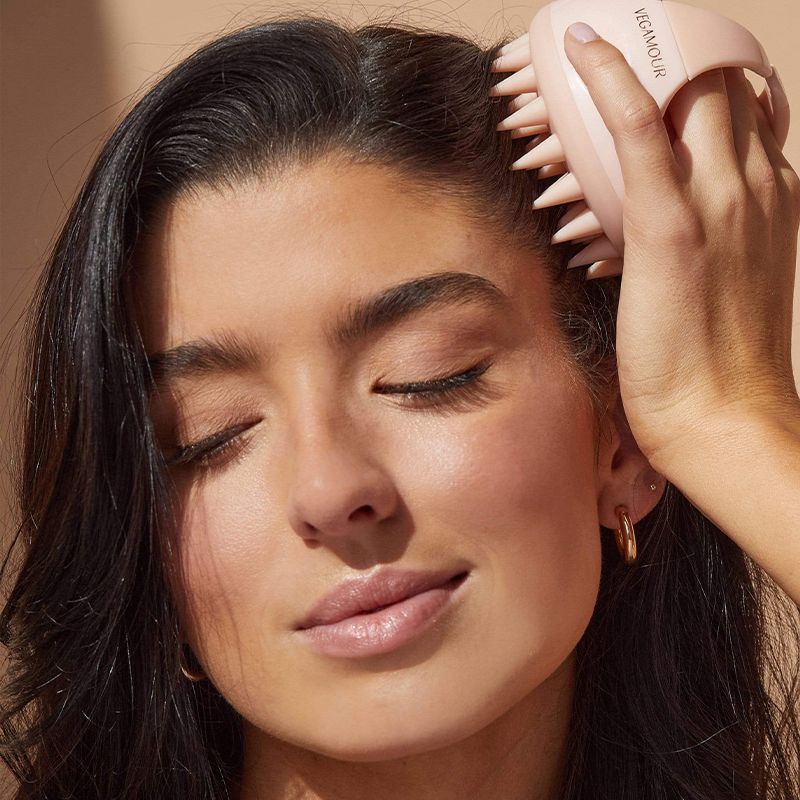Okay—we’ll admit: We haven’t always been the best at scalp care. With a focus and emphasis on hairstyling and appearance, it’s easy to get carried away with your strands’ lengths and skip out on its foundation. Still, scalp care is an essential part of any hair care regimen.
If you have natural hair, like me, layering oils, conditioners, and styling products, paired with sebum and sweat from daily life, can create buildup or discomfort on your scalp. Thankfully the haircare aisle has evolved with a wide range of products and tools to help keep your scalp clean and healthy, and scalp massagers are at the forefront.
The tools have been popping up on shelves and in hair-focused content on the web, with influencers and experts touting the stimulating benefits of the tool. Some of my favorite brands like Rizos Curls and Brush With The Best have added scalp massagers to their product lineup, making me curious if it’s worth adding one to my routine. Ahead, we spoke to experts about the buzzy scalp tools.
Meet the Expert
- Aleta Simmons, MD, is a board-certified dermatologist based in Nashville, Tennessee. She serves as the Assistant Professor and Diversity Champion of Dermatology at Vanderbilt University Medical Center.
- Heather Woolery-Lloyd, MD, is a board-certified dermatologist based in Florida and the creator of Specific Beauty, a skincare line designed to treat hyperpigmentation.
What Are The Benefits of Scalp Massagers?
Before diving into expert thoughts on scalp massagers, it’s important to note that there is little scientific evidence of their ability to grow hair. However, experts say that massaging your scalp can help increase blood circulation, positively impacting your hair and scalp. Think about that relaxing moment when your hairstylist takes extra time to shampoo your scalp at the bowl. The tension created by their fingers helps cleanse and stimulate blood flow. Scalp massagers provide similar relief. “Scalp massagers can cause mechanical stress on the scalp, potentially leading to alterations in gene expression,” Aleta Simmons, MD, a board-certified dermatologist, says. “These changes may lead to increased hair thickness.”
Beyond the claims that scalp massagers may enhance hair growth, they ultimately just feel really good. Many brands and experts encourage people to use scalp massagers in tandem with a scalp treatment to help product application and absorption. However, scalp massagers are great for relieving tension, itching, or incorporating another form of massage into your routine.
How to Use Scalp Massagers
Using a scalp massager might sound as simple as rubbing the tool onto your skin. Still, Heather Woolery-Lloyd, MD, a board-certified dermatologist, says it could damage your hair follicles if done improperly. With most beauty treatments, being gentle with your scalp is essential. You can use a scalp massager in gentle circular motions on wet or dry hair. It’s recommended to incorporate a scalp massager in your shower routine to maximize the benefits of products like scalp scrubs and serums.
How to Choose the Right Scalp Massager For Your Hair
We all have different hair textures and scalps, so finding the right scalp massager for you is key to getting the most out of the tool. The popularity of these handy tools means plenty of options to consider.
For example, using a brush with thinner bristle to quickly exfoliate the scalp like Tangle Teezer Scalp Exfoliator and Massager ($10) might work if dealing with regular product buildup. If you’ve experienced hair loss or have a sensitive scalp, Simmons and Woolery-Llyod recommend silicon bristles to help prevent breakage and reduce tangles or knots in the hair. We like Kitsch Pro Scalp Exfoliator, which has skinnier bristles to get in between thick strands. We also love Vegamour’s Revitalizing Scalp Massager ($18), which has sturdy bristles and an easy-to-hold design, so you can really get in there. I’ve found that the Maxsoft Hair Scalp Massager ($7) is a super affordable option that provides relief deep in my roots.
The Bottom Line
When building a routine for your scalp it’s important first to assess your needs, then fit products that help accordingly. There’s a large selection of scalp tools that claim to be the best, so reading reviews, consuming content, and asking an expert if you’re unsure is the best route. Still, if you’ve just taken down a protective style, feel some trapped tension, or have an itch that fingers won’t fix, a good scalp massage might be a game-changing part of your hair care routine.
How to Exfoliate Your Scalp (and Why You Should)










